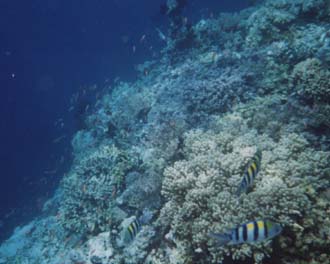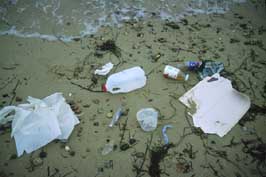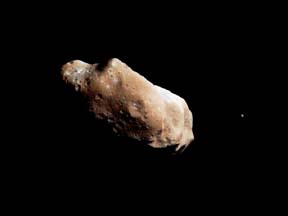The photograph above shows two branches of elkhorn coral growing in the water near Key West, Florida. The brown and bumpy parts of the coral branches are alive and healthy. The white spot on the left branch is infected with the bacteria.
Click on image for full size
Courtesy of University of Georgia
Coral killer on the loose: Are coral reefs dying because of our waste?
News story originally written on June 28, 2002
New research has found that bacteria are responsible for killing many corals in the shallow water reefs near the Florida Keys. The bacteria are usually found in the intestines of people and other animals. That means that when you flush the toilet, you have flushed some of these bacteria down the drain with the rest. It doesn’t hurt people; it lives within us without making us sick. Little coral animals, however, can be killed by it.
The bacteria hurt only one species of coral, elkhorn coral. Elkhorn coral was once the most common species, but now it is difficult to find in the water near Florida, and it may soon be on the endangered species list.
Scientists have been observing the poor health of the corals near Florida for many years. They called the white spots that formed on elkhorn corals white pox disease and found that it could spread very fast to the all the elkhorn corals within a reef. They could see how the disease was killing the corals, but they didn’t know what caused it until Kathryn Patterson, a scientist on the research team, found the bacteria in the bodies of sick corals.
Researchers still don’t know exactly how the bacteria get into the corals, but they suspect that sewage pollution is the cause. If water flushed down toilets in southern Florida does not receive proper treatment before it winds up in the ocean, it may contain bacteria that kill corals. “We must maintain the highest possible water quality standards in the Florida Keys,” said James Porter, head of the research team.
Reef corals, like elkhorn coral, build large stony skeletons on the shallow ocean floor in warm, tropical places. They provide a home and food for many other reef creatures. “These coral reefs are so beautiful and so important,” said James Porter, “We must do out best to protect them.”
Last modified August 6, 2002 by Lisa Gardiner.
You might also be interested in:

After many years of damage, scientists report that coral reefs in several parts of the world have started to recover during 2002! The reefs with improving health are located in areas that are protected
...more
Take a look at this picture! The light blue parts are coral reefs just under the surface of the Red Sea. The crew of the International Space Station (ISS) took the picture on May 20, 2003 as they looked
...more
The term "Tragedy of the Commons" was coined by Garrett Hardin in a 1968 magazine article, however, the idea dates back to the days of Aristotle. Briefly, it holds that a shared resource is inevitably
...more
It was another exciting and frustrating year for the space science program. It seemed that every step forward led to one backwards. Either way, NASA led the way to a great century of discovery. Unfortunately,
...more
The Space Shuttle Discovery lifted off from Kennedy Space Center on October 29th at 2:19 p.m. EST. The weather was great as Discovery took 8 1/2 minutes to reach orbit. This was the United States' 123rd
...more
A moon was discovered orbiting the asteroid, Eugenia. This is only the second time in history that a satellite has been seen circling an asteroid. A special mirror allowed scientists to find the moon
...more
Will Russia ever put the service module for the International Space Station in space? NASA officials want an answer from the Russian government. The necessary service module is currently waiting to be
...more















